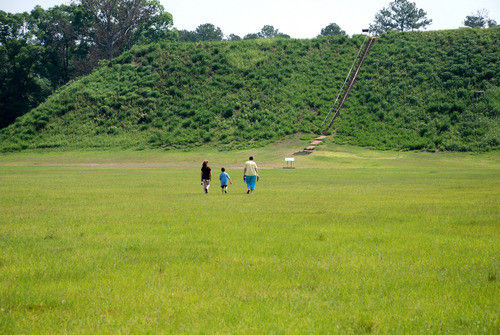
One such earthen pyramid was constructed in the Florida panhandle at a site known today as the Letchworth-Love Mounds. This "mound," or more accurately "earthen pyramid," is the tallest such earthwork in Florida at over 46 feet high. Pottery collected from this site was mostly of a variety known as Weeden Island. Weeden Island pottery contains many designs and motifs which appear Mesoamerican in orign. Weeden Island pottery likely evolved from another type of pottery known as Swift Creek which was also decorated with a series of designs and symbols which several researchers have noted have a Mesoamerican-appearance.
Across the border in Georgia another huge earthen pyramid was also constructed at the same time as Letchworth. The site, known as Kolomoki Mounds, also features large collections of both Swift Creek and Weeden Island pottery. The archaeologist who recently studied the site noted in his book, Kolomoki: Settlement, Ceremony & Status in the Deep South, that Kolomoki was the most populated settlement north of Mexico during its time period. The large pyramid at Kolomoki has a base larger than a football field and rises 57 feet high.
The question remains as to who built these structures and why. Mainstream archaeologists argue that there is a long history of mound building in the southeast and these sites are simply a natural evolution of these pre-existing cultures. They also note that Swift Creek and Weeden Island pottery can be shown to have evolved from local pottery traditions which date back thousands of years.
It is true that Florida's Indians had constructed small sand and shell burial mounds for thousands of years but nothing on the scale and complexity of Letchworth. Researchers have noted this earthen pyramid is "one of the largest earthen mounds in Florida and one of the most architecturally complex." How did the local tribes make this quantum leap from simple sand and shell mounds to something as architecturally complex as Letchworth Mounds?
It is also true that Swift Creek pottery is a natural evolution of local pottery styles. Yet the symbols on this pottery do not have this same natural evolution. Many of these Mesoamerican-style symbols make their first appearance in the southeast on Swift Creek pottery. And none of this explains the arrival of corn, a known Mesoamerican crop, which also showed up at the same time as these symbols and pyramids.
One possibility is a small group of elites arrived in Florida fleeing from warfare and/or possible execution/sacrifice by their conquerors in Mesoamerica. Evidence unearthed at the Mayan site of Waka in Guatemala showed that elite women, including pregnant women, were specifically sacrificed in an attempt to wipe out the royal blood line of the city. If you were an elite woman with family and children, would you accept this fate or would you attempt to escape to a place you would not be found and your family would be safe?
Archaeologists have found Guatemalan jade dating to 500 BC on the island of Antiqua in the eastern Caribbean, a distance of 1700 miles away. Thus archaeologists know the Maya were already exploring the Caribbean at this time. Since Florida is only 450 miles away it seems unlikely they were unaware of its existence.
It is unlikely these elites would have had time to load up the boats with lots of personal belongings if they were fleeing capture which is likely why no Mayan artifacts have ever been found in the southeast. Since corn was a food of the commoners, not the elite, it seems likely they brought not only their family but also their servants. These servants likely brought corn along with them on this journey to eat as well as to plant and re-establish their food source once they arrived in Florida.
Once in Florida they would have likely been seen as "gods" much like the Spanish when they first arrived in Mexico. This would have given them great influence and power over the locals. They would have utilized local artisans to create their pottery but placed their own symbols and designs on them. Likewise they would have used local Indians to provide the labor to build the mounds but would have been responsible for its design.
Interestingly, at one of the earliest Weeden Island earthen pyramid sites in Florida known as the McKeithen site, a female ruler was unearthed from its burial mound. Could she have been an elite woman who fled from Waka? Coincidentally, the area near these mounds feature the following Native American placenames: Wakulla, Wakulla Beach, Wakulla Springs, Wakulla River. (See Map) Wakulla was the name recorded by the earliest Spanish in the area and is likely a corruption of the Hitchiti word Waka-le, "Waka People."
Did an elite female, her family and servants flee from Waka in Guatemala after the site was attacked? Did they hire Poton Maya mariners, the master seafarers of the Maya world, to take them someplace safe where their attackers could not find them and execute them thereby destroying the royal lineage? Was this place of safety along the Florida coast at the present day location of Wakulla, Florida and nearby Letchworth Mounds?
Only further research can answer these questions but you can visit both Letchworth Mounds and Kolomoki Mounds to see them for yourself.



Reader Comments
to our Newsletter